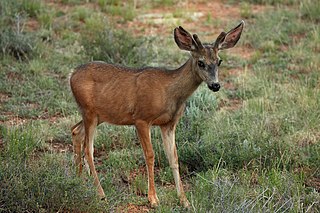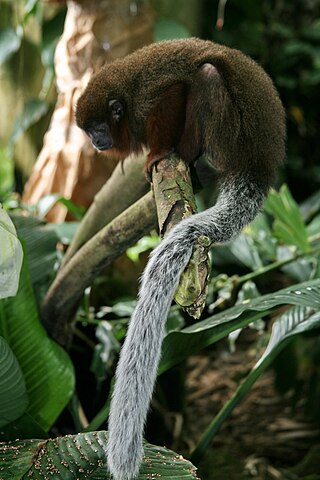
Fungus-growing ants comprise all the known fungus-growing ant species participating in ant–fungus mutualism. They are known for cutting grasses and leaves, carrying them to their colonies' nests, and using them to grow fungus on which they later feed.

Trachypithecus is a genus of Old World monkeys containing species known as lutungs, langurs, or leaf monkeys. Their range is much of Southeast Asia.

The Microhylidae, commonly known as narrow-mouthed frogs, are a geographically widespread family of frogs. The 683 species are in 57 genera and 11 subfamilies.
Fibrobacterota is a small bacterial phylum which includes many of the major rumen bacteria, allowing for the degradation of plant-based cellulose in ruminant animals. Members of this phylum were categorized in other phyla. The genus Fibrobacter was removed from the genus Bacteroides in 1988.

Plethodontohyla is a genus of microhylid frogs endemic to Madagascar.

Stumpffia is a genus of microhylid frogs that are endemic to Madagascar. They are mostly brown frogs that typically live among leaf litter. S. contumelia has a snout–vent length of about 8–9 mm (0.31–0.35 in), making it one of the world's smallest frogs, and several others in the genus are only slightly larger. The largest species is no more than 28 mm (1.1 in).

The genus Eligmodontia consists of five or six species of South American sigmodontine mice restricted to Bolivia, Chile, and Argentina. Species of Eligmodontia occur along the eastern side of the Andes Mountains, in Patagonia, and in the Chaco thorn forest of South America. They can be found in arid and semiarid habitats and in both high and low elevation areas. These rodents are commonly known as gerbil mice or by their local name lauchas. Sometimes they are also called silky desert mice, highland desert mice or silky-footed mice. The closest living relatives are probably the chaco mice (Andalgalomys), the leaf-eared mice, and Salinomys.

The rufous woodpecker is a medium-sized brown woodpecker native to South and Southeast Asia. It is short-billed, foraging in pairs on small insects, particularly ants and termites, in scrub, evergreen, and deciduous forests and is noted for building its nest within the carton nests of arboreal ants in the genus Crematogaster. It was for sometime placed in the otherwise Neotropical genus Celeus but this has been shown to be a case of evolutionary convergence and molecular phylogenetic studies support its placement in the monotypic genus Micropternus.

The plushcap is a species of bird in the tanager family Thraupidae and it is the only member of the genus Catamblyrhynchus.

The Capreolinae, Odocoileinae, or the New World deer are a subfamily of deer. Alternatively, they are known as the telemetacarpal deer, due to their bone structure being different from the plesiometacarpal deer subfamily Cervinae. The telemetacarpal deer maintain their distal lateral metacarpals, while the plesiometacarpal deer maintain only their proximal lateral metacarpals. The Capreolinae are believed to have originated in the Middle Miocene, between 7.7 and 11.5 million years ago, in Central Asia.

The forest robin or orange-breasted forest robin is a species of bird from Central and West Africa. It is monotypic in the genus Stiphrornis. It has been placed in the family Turdidae, but is now generally placed in Muscicapidae in the group popularly known as chats. Most taxonomists consider it a single species, but some reviews have recommended recognizing 5 species. It has a total length of around 12 cm, has dark upperparts, and a throat and chest that, depending on the subspecies, is yellow-orange or deep orange.

Trachymyrmex is a genus of fungus-growing ants in the subfamily Myrmicinae. The genus is mainly tropical in distribution, with most species being found in Central and South America.

Cyphomyrmex is a genus of fungus-growing ants found primarily in South and Central America. However, some species do come up to the southern portion of North America. They grow a variety of fungi in the tribe Leucocoprineae. Most fungal gardens are grown in small nodules, some species to cultivate entire mycelium, though. Colonies are monogynous and are relatively small with about 100 workers on average.

Cinctura is a genus of fasciolariid sea snails known as the banded tulip shells. Species in this genus were previously grouped in the closely related genus Fasciolaria.

Hyantis is a monotypic nymphalid butterfly genus. Its sole species is Hyantis hodeva, which is found in New Guinea. It is uncertain which tribe this butterfly should be placed within.

Trachymyrmex nogalensis is a species of higher myrmicine in the family Formicidae.

Brachymyrmex depilis is a species of ant in the family Formicidae.

Plecturocebus is one of three genera of titi monkeys.

Humboldt's squirrel monkey is a species of squirrel monkey from Brazil, Colombia, Ecuador, Peru and Venezuela. It had previously been considered a subspecies of the common squirrel monkey, S. scuireus, but was elevated to full species status based on a genetic study by Carretero-Pinzón in 2009. A genetic study by Jessica Lynch Alfaro, et al indicated that the Ecuadorian squirrel monkey may be synonymous with Saimiri cassiquiarensis. As of 2018, the Ecuadorian squirrel monkey is generally regarded as a subspecies of Humboldt's squirrel monkey, S. cassiquiarensis macrodon.
Myrmecicultor is a monotypic genus of North American spiders in the family Myrmecicultoridae. It contains the single species, Myrmecicultor chihuahuensis, and was first described by M. J. Ramírez, C. J. Grismado and D. Ubick in 2019. It is native to the Chihuahuan Desert, from the Big Bend region of Texas to Coahuila and Aguascalientes in Mexico. Collected specimens were found in pitfall traps where three species of harvester ants are most active: Pogonomyrmex rugosus, Novomessor albisetosis, and Novomessor cockerelli.



















